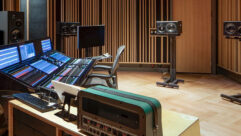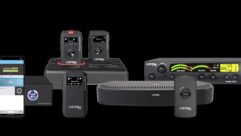
Telecom Giant Shines In New Facility
When Lucent Technologies merged with the French telecom leader Alcatel last November, the leaders of the new company wanted it to be cutting edge in every way.
Russ Perry, IT support officer at Alcatel-Lucent, recalls that the conference room at the U.S. headquarters in Murray Hill, N.J., then relied on an ISDN connection supporting an old projection system. “The design had not changed since 1996,” he says.
CHALLENGE: Create a new videoconference facility that lives up to its owners’ state-of-the-art image — and do it quickly.
SOLUTION: A fully high-definition, three-display room with intuitive user controls and infrastructure that is ready to move to 1080p video in the future.
When Lucent Technologies merged with the French telecom leader Alcatel last November, the leaders of the new company wanted it to be cutting edge in every way.
One of the first places they looked at for technology leadership was in the company’s video-conferencing resources, and what the top brass saw there was not even close to measuring up.
Alcatel-Lucent’s priority for its new facilities capabilities was easy: technician-free conferencing, a goal met by features ranging from extensive presets in the control system to a world-time clock above the main screen.
A mandate soon arrived from the “C” level to replace the system with new facilities that would not only integrate today’s state of the art, but would be ready to upgrade to even higher performance in the future.
“After the merger, we had much more of a global reach,” says Perry. “Senior leaders wanted to stay off the jets a little more and have their meetings via conferencing. We also have a philosophy of showcasing our own products. We’re trying to make better use of our network, using IP to make some very high-bandwidth calls.” After all, when your corporate pedigree includes the innovative AT&T Bell Labs, people hold you to a pretty high standard.
Alcatel-Lucent called in systems integrator Verrex Corp. of Mountainside, N.J. Verrex had designed and built the existing system and provided ongoing maintenance.
IS THE GAIN FROM 1080P WORTH IT?
Moving up to 1080p video, the highest-definition standard available, presents potential users with two critical situations: how to do it, but perhaps more importantly, should they do it? Verrex’s Anthony Zamarin notes that upgrading the recently completed Alcatel-Lucent conference facility to 1080p depends on availability of a new codec from Polycom. Often, there are many other factors to consider, ranging from the capabilities of hardware such as routers, to the network bandwidth available, to the fundamental question of whether 1080p video will add enough value to the conference to be worth its cost.
Polycom recently announced an initiative, the High Definition Readiness program, to help clients assess the quality of service, bandwidth and call quality of their networks and determine what additions and improvements they need to move to high definition. The company notes, for instance, that “uncompressed HD takes nearly six times more disk space than uncompressed video, and requires six times the bandwidth to play in real time.”
Pro AV columnist and video display expert Pete Putman believes 720p video is likely to be more than good enough for almost all conferencing applications, especially given the dramatically higher costs of the available 1080p hardware. “There’s nothing available at 1080p except for very, very expensive equipment,” he says. “Nobody is going to install that in a conferencing environment.”
Is 1080p better? In a recent analysis, Putman wrote, “It appears that the strongest arguments for 1080p imaging apply to screen sizes measuring 60 inches or larger. Smaller HDTVs seem to work fine with 720p or 768p native resolution at typical viewing distances, no matter the resolution of the HD content.”
Viewing distance is at the heart of the question. The closer the viewer gets to a large screen, the added resolution of 1080p can become more noticeable. Putman says the maximum viewing distance for identifying improved resolution is three times the screen height. In an install such as the one at Alcatel-Lucent, that’s 15 feet.
“Sit farther away or use a smaller screen, and you’re not likely to see the difference,” says Putman.
The assignment to Verrex was threefold:
- Create a new conferencing system to deliver high-definition video and high-quality sound with minimal latency.
- Be sure the facility can move to 1080p video-conferencing displays in the future.
- Build it fast.
“The client wanted everything to be future-proof,” says Anthony Zamarin, Verrex vice president. “They anticipated that 1080p high-def video-conferencing is going to be available, and wanted us to design a system that not only can provide optimal performance today, but will be upgradeable without replacing a lot of the infrastructure.”
And the speed of construction? “We took a 16-week project and did it in approximately six weeks,” says Zamarin.
At the heart of the new conference facility is a Barco iCon H600 LCD projector, and a Stewart 60- x 90-inch, 16:9 rear projection screen. Two NEC 46-inch LCD panels flank the central screen. The Barco projector delivers 1080p native resolution, while the two LCD panels are native 1080i.
The native 1080p resolution of the Barco iCon H600 LCD projector was a key to the facility’s futureproofing.
At present, 720p is the spec for codecs at the Alcatel-Lucent facility. Todd Hutchins, vice president for design development at Verrex, says the infrastructure will support 1080p when the codec upgrades are available. Then, the room can move to 1080p very quickly, he says.
Verrex also specified a Polycom HDX 9004 videoconferencing codec, Eagle-Eye HD cameras.
Content can be routed to any of the screens from a variety of sources, choosing among remote site video, data displays and other sources. It’s controlled by an AMX NI-4100 Netlinx integrated controller, accessed by an 8.4 inch Modero wireless touchpanel at the lectern and a 12-inch Modero tabletop panel.
In programming the controls, maximum ease of use was a priority for Verrex, says Zamarin. Any executive who wants to hold a conference should be able to use the room without a technician, for example, relying on a variety of presets accessed by intuitive commands from the touchpanels.
Says Hutchins, “We spent a lot of time dealing with high quality issues in audio. The sound is very good.”
Ten Tannoy CMS501 ceiling loudspeakers, two 18AW and two C10S subwoofers deliver this sound, supported by two ClearOne XAP 800 audio matrix mixers and QSC amplifiers. A dozen Clockaudio push-to-talk tabletop microphones are each equipped with a Harry Joseph & Associates “Hushbutton,” which features lighting cues as the system warms up and helps identify which mics are active or muted at any time.
All told, Alcatel-Lucent spent about $380,000 on AV for the room, including hardware, installation, and programming. An additional $180,000 covered the extensive new construction.
“This is the first of four high-definition rooms we have in progress,” says Perry. Two more rooms are under construction at company headquarters in Paris, and a fourth will be added at Murray Hill. Later, eight regional headquarters will be similarly equipped.
The global system will be used chiefly for internal communications, though it also will upgrade the company’s image when it conferences with customers, business allies and other outside parties.
Status collars on the tabletop mics deliver extensive information to users.
Given top management’s priority of improving Alcatel-Lucent’s videoconferencing, a highly compressed schedule was clearly in order.
“The client put the entire project management in our hands,” says Zamarin. Verrex worked closely with Alcatel-Lucent’s facilities managers, architect, lighting consultant and others to create project milestones.
“Everything had to fall into place to meet this schedule, with nothing going wrong,” says Zamarin. “The fact that we were working with cutting-edge technology was really a challenge. Some of the equipment we were integrating had just become available.”
For example, the Polycom HDX was new, and before this project, it had not been integrated by Verrex nor controlled by AMX.
“The only way we could make this happen was to work as a team,” he says. “Instead of handing it off from one department to another, we all had to get into it at once.”
FOR MORE INFORMATION
Illumination Artswww.illuminationarts.com
Alcatel-Lucentwww.alcatel-lucent.com
AMXwww.amx.com
Barcowww.barco.com
ClearOnewww.clearone.com
ClockAudiowww.clockaudio.com
Harry Joseph & Associateswww.hja.com
Polycomwww.polycom.com
Stewart Filmscreenwww.stewartfilm.com
Tannoywww.tannoy.com
Verrex ww.verrex.com
Hutchins recalls “a lot of early front-end work. We were not even talking about weeks to turn drawings around, but a matter of days.”
In the end, Alcatel-Lucent believes it was able to roll out a videoconferencing facility worthy of its history and mission. Perry, for example, recalls how often in the past, videoconference partners would refer to the company’s AT&T Bell Laboratories roots and say something like, “After all, you invented this.”
John McKeon is a freelance journalist in Chevy Chase, Md. He is also the author of a recent novel, “Demented Choirs.” John can be reached at [email protected].










